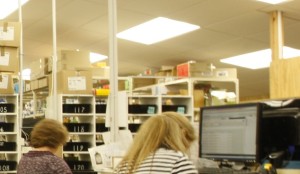Guide launched to close office refurbishment waste loop – guinea pig office wanted!
 MEDIA RELEASE – Sustainable Business Network
MEDIA RELEASE – Sustainable Business Network
24th June 2015
World’s first guide to ‘circular’ office launched
Office refurbishment in New Zealand is set to undergo a shake up with the launch of the world’s first guide to creating an office using ‘circular’ principles – minimising waste and maximising the life of all materials.
The guide, which has been produced by a cross-industry collaboration of nine organisations, will be launched in Auckland on 7th July 2015.
The authors are now looking for a New Zealand office in need of refurbishment to become the world’s first Circular Economy Model Office.
James Griffin, Transformation Leader Mega Efficiency at the Sustainable Business Network, says he hopes the Circular Economy Model Office Guide will be the first step in revolutionising the office refurbishment industry.
“At present, half of all waste generated in New Zealand is estimated to come from construction and demolition,” he says. “There is therefore enormous scope to reduce waste in this sector and this guide is a practical tool aimed at helping all players involved in the office refurbishment industry to do so.
“Creating a circular economy office is a straightforward and pragmatic process, essentially following the principles of making the most use of materials offices already have. It will save companies money, as well as having both environmental and social benefits. What business wouldn’t want to do that?”
The aim of the Circular Economy Model Office Guide is to minimise waste created by the refurbishment and build of offices by using the principles of a ‘circular economy’: a system that operates in a closed loop with no waste, where the lifecycle of materials is maximised, usage optimised and at the end of life all materials are re-used.
The circular economy is a viable and more efficient alternative to the prevailing linear model – ‘take-make-waste’ – where tonnes of needless waste from office refurbishments and builds end up in landfill sites around the country.
The Guide, which is aimed at architects, designers, project managers and construction managers, outlines simple principles, provides ‘how to’ information and shares practical knowledge. It explains how businesses can make their office refurbishment more circular through five stages: Cataloguing and analysis of existing materials; Design; Build; Soft fit-out/furniture; and Review and evaluation.
All companies taking part have the opportunity to produce a self-declaration at the end, specifying the percentage of materials that were reused, new materials with an end of life solution or product stewardship scheme, recycled content in new materials and materials diverted from landfill.
James says the circular economy offers New Zealand a tremendous opportunity for sustainable growth – growth that does not rely on using more resources but optimises the utilisation of resources already in circulation.
“The next step is to put the guide into practice in an office undergoing refurbishment, so we’re on the look out for a business that wants to become the world’s first Circular Economy Model Office or CEMO.”
Gordon Wiffen, General Manager of Philips Lighting NZ, says that reducing the new resources we use is simply the right thing to do, which is why the company has got involved in the CEMO project.
“From an economic point of view, embedding the circular economy concept promises additional value creation potential across Philips’ value chains,” he says. “A more effective use of materials brings cost savings and helps us develop new markets as well as growing existing ones.”
Robb Donzé, Managing Director of INZIDE Commercial, says the CEMO project resounded with him because it’s a great way of raising the profile of product stewardship.
“There has been a lot of attention given to ‘green-style’ buildings but stuff from offices is still ending up in landfill,” he says. “Most products used to fit out offices in New Zealand are imported from overseas. In many cases, there are end of life options that can keep them from becoming landfill but it’s not yet in people’s consciousness. We need to make product suppliers responsible for whole life cycle of their products.”
Organisations contributing to the CEMO Guide include Auckland Council, Creative Spaces, EnviroSpec, INZIDE Commercial, Jasmax/Johansson Group, MasterSpec, New Zealand Green Building Council, Sustainable Business Network and Warren & Mahoney.
For further information about the project or if you are interested in putting your office forward to be the world’s first CEMO, please contact James Griffin: [email protected]
The CEMO Guide will be officially launched on 7th July from 5-7pm at Auckland Council. To attend, please click here.
To view the Circular Economy Model Office Guide click here.
loading...
loading...
Tags: Business



Voices of our community